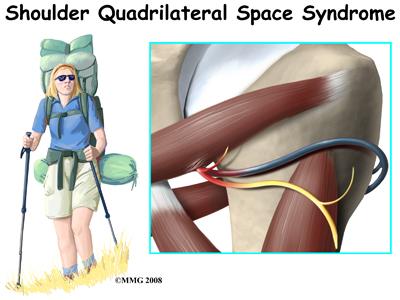Quadrilateral Space Syndrome

Overview
Quadrilateral Space Syndrome (QSS) is a rare condition causing pain in the shoulder and arm. It results from compression in a small area located in the upper back— the quadrilateral space. This space houses important nerves and blood vessels, including the axillary nerve and the posterior circumflex humeral artery. If these structures become compressed, it can lead to various symptoms typically associated with QSS. Found more in athletes or individuals who frequently perform overhead activities, its diagnosis can be challenging due to its similarities with other shoulder-related conditions.
Types
While there are no distinct types of Quadrilateral Space Syndrome, the condition can vary in severity depending on the degree of nerve and blood vessel compression in the quadrilateral space.
Causes
QSS is primarily caused by compression of the axillary nerve in the quadrilateral space. This can result from several factors:
-
- Trauma or injury to the shoulder
-
- Constant, repetitive overhead movements such as those common in swimming, baseball, or weightlifting.
-
- Anatomical abnormalities or conditions like fibrous bands or tumors which reduce space in the shoulder area.
Symptoms
The most common symptom of QSS is pain in the shoulder or upper arm, typically intensifying during specific movements. Other symptoms can include:
-
- Weakness in the shoulder
-
- Numbness or tingling in the arm
-
- Difficulty lifting objects
-
- Reduced range of motion in the shoulder
Diagnosis
Diagnosing QSS can be tricky, due to its symptomatic similarities with other shoulder conditions. Diagnosis typically includes:
-
- Physical examination: A doctor will closely examine your shoulder, checking for areas of pain and measuring the range of motion.
-
- Imaging tests: These might include an MRI or ultrasound to visualize the shoulder’s internal structures.
-
- Nerve studies: To evaluate potential nerve damage, doctors may employ nerve conduction studies or electromyography (EMG).
Treatment Options
Treatment for QSS often depends on the severity of the condition and individual’s symptoms. Here are some potential treatment options:
-
- Physical therapy: Exercise routines designed by a physical therapist can strengthen the shoulder muscles, reducing pressure on the quadrilateral space.
-
- Medications: Non-steroidal anti-inflammatory drugs or corticosteroid injections can help manage pain and reduce inflammation.
-
- Surgery: In severe cases where conservative treatment fails, surgery might be required to decompress the quadrilateral space.
Living With Quadrilateral Space Syndrome
Living with QSS can be a challenge, but here are some tips to manage the condition:
-
- Regular Physical Therapy: Maintaining a consistent physical therapy routine can play an integral part in managing QSS and improving shoulder function.
-
- Medication Management: Regularly taking the prescribed medication helps in containing pain and inflammation.
-
- Lifestyle Changes: Modifying daily activities to limit overhead movements might help in reducing discomfort and improving the condition.
-
- Coping Strategies: Techniques such as relaxation or pain management strategies can help cope with persistent pain.
When to Seek Help
If you’re experiencing prolonged shoulder or upper arm pain, especially with a history of repetitive overhead activities or trauma, seek immediate medical attention. Also, if you’re already diagnosed with QSS and your symptoms intensify, or if your treatment plan doesn’t seem to be working, consult your doctor right away. Early and accurate diagnosis can significantly impact the success of your treatment and recovery.
